Morris & Fan. Reservoir Sedimentation Handbook
Подождите немного. Документ загружается.

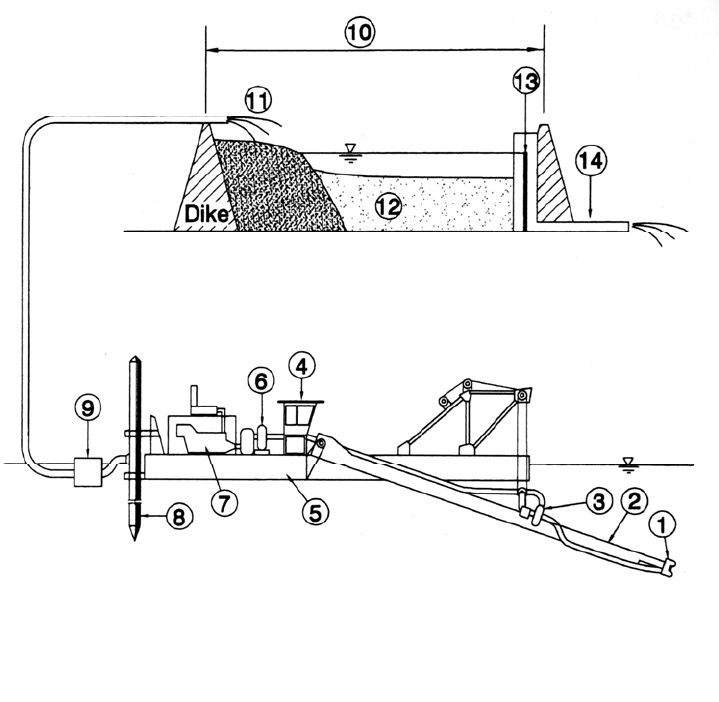
SEDIMENT EXCAVATION 16.6
FIGURE 16.3 Schematic diagram of a hydraulic dredge and disposal area illustrating: (1)
cutterhead, (2) ladder, (3) ladder pump, (4) controls, (5) hull, (6) main pump, (7) engine, (8)
spud, (9) float and discharge pipeline, (10) disposal or containment area with perimeter dike,
(11) inlet zone where coarse sediment tends to accumulate and mound, (12) fine sedimen
t
deposits, (13) adjustable effluent weir, (14) discharge of clarified effluent.
Fi
gure 16.3 schematically illustrates a hydraulic dredging system. Hydraulic dredges are
sized according to the diameter of their suction pipeline (e.g., a 25-cm dredge), or a
combination of suction and discharge diameter. The cutterhead consists of a series of
blades on a variable-speed drive, rotating between about 15 and 30 r/min. The cutter-head
is worked back and forth across the active face to dislodge the sediment, which is picked
up by the suction line. Many cutterhead variations are available, and in flowable material
a plain suction end without a cutterhead may be used. Some small dredges use a
horizontal auger to deliver fine sediment to the suction line, with a hood to reduce
turbidity generation (Fig. 16.4).
The pumping unit may consist of a centrifugal pump located on the dredge or a
submerged ladder pump. The advance of the dredge across the deposits may be controlled
by pivoting on the spuds, which are alternately lifted and set to produce the pattern shown
in Fig. 16.5. Lateral swing is controlled by guy wires tied to anchors or the shore. Cables
may also be used to control the motion of the dredge without the use of a spud. The
dredge shown in Fig. 16.4 is winched forward along its track by a cable anchored on the
shore.
In conventional suction dredges, the pump is located within the dredge hull at the
water surface. However, because the specific gravity of the slurry is higher than the
surrounding water, when excavation depths exceed about 10 m, or at lesser depths in
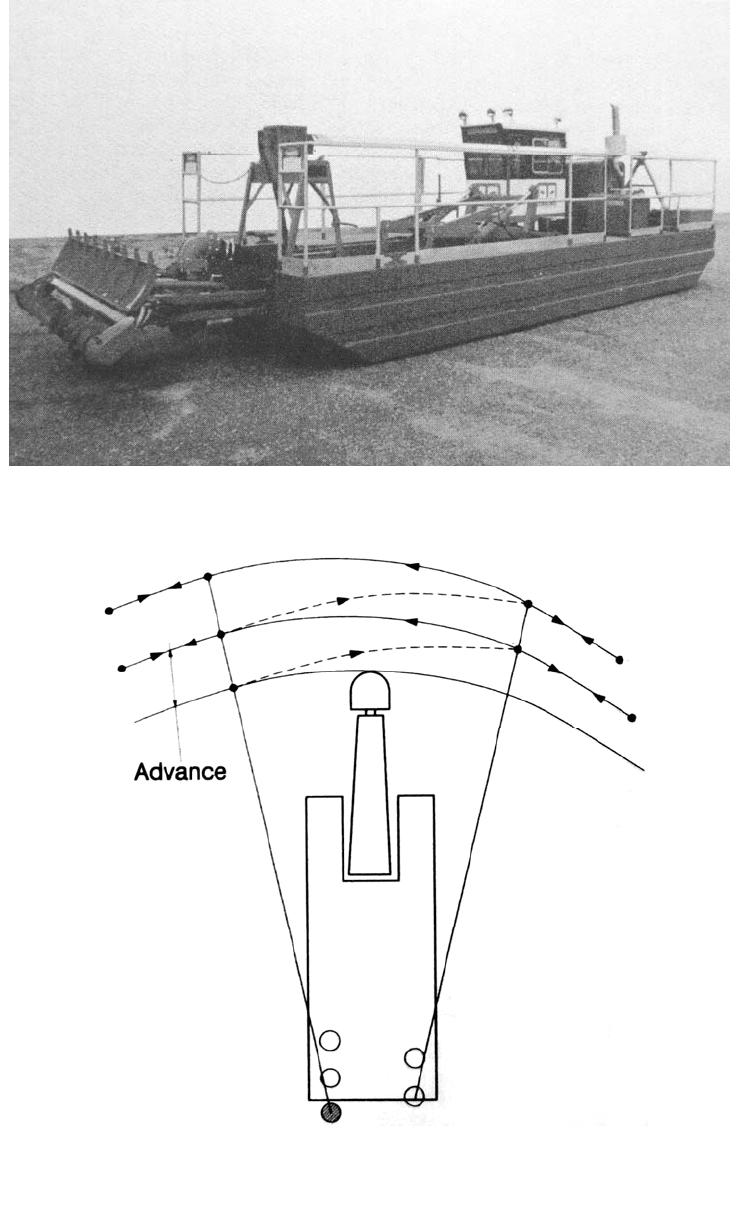
SEDIMENT EXCAVATION 16.7
FIGURE 16.4 Small portable dredge with auger-type cutterhead suitable for use in unconsolidated
fine sediment (courtesy Elliott International).
reservoirs at high elevations above sea level where atmospheric pressure limitations can
FIGURE 16.5 Forward motion of a cutterhead dredge pivoting on spuds.
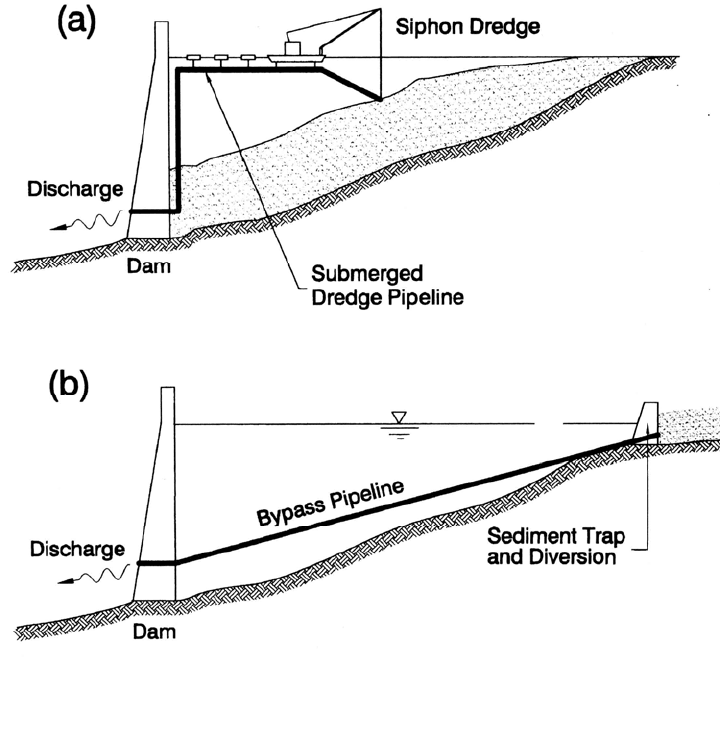
SEDIMENT EXCAVATION 16.8
significantly reduce efficiency and induce pump cavitation. As a rule of thumb, the
maximum output of a conventional cutterhead dredge at 15 m digging depth is about half
of its output at 3 m digging depth (Turner, 1996). The suction head limitation may be
overcome and production increased by locating a pump below the water surface on the
ladder supporting the cutter-head, a configuration termed a ladder pump dredge and
illustrated in Fig. 16.3.
Along rivers which have been impounded for navigational purposes, large dredges
may be towed to the dredging site. However, at landlocked reservoirs it is necessary to
use transportable dredges which can be broken down and trucked to the site. The largest
transportable dredges have a 760-mm (30-in) suction with a 5000-hp pumping unit and a
solids-handling capacity of about 2300 m
3
/h (Turner, 1995). For large and prolonged
dredging projects, dredges are assembled at the reservoir for permanent use.
16.3.2 Siphon Dredge
Siphon dredges are differentiated from a conventional hydraulic dredge by the absence of
a pump, and a discharge line that is continuously submerged. The slurry is forced through
the pipeline by the differential head between the water surface in the reservoir and the
discharge point, located at the lowest possible point on the dam (Fig. 16.6a).
Many small siphon dredges are used in Chinese reservoirs, in which a plain-end
suction line is suspended by cable from a simple barge which is moved from one area to
FIGURE 16.6 (a) Mobile siphon dredge. (b) Fixed sediment bypass pipeline.
SEDIMENT EXCAVATION 16.9
another to suction fine sediment. Siphon dredges may be configured with a plain suction
end or a mechanical cutterhead; the cutterhead-type siphon dredge installed at Valdesia
Reservoir is described later in this chapter. There are two principal limitations to siphon
dredging. First, because of the low available head, deployment is generally limited to
areas rather close to the dam (e.g., 2 km). This distance will vary as a function of dam
height, pipe diameter, and the material being dredged. Second, siphon dredges discharge
to the river below the dam, a practice not generally permitted in industrialized countries
because of environmental concerns.
The potential use of a permanent siphon-type arrangement to pass sediment beyond a
dam has been reviewed by Hotchkiss and Huang (1995), and represents a possible
approach for bypassing sand over short distances. A permanent sand bypass system (Fig.
16.6b) can be environmentally superior to intermittent flushing, and was proposed but not
implemented at Spencer Dam on the Niobrara River (Sec. 18.4.9). Limitations inherent in
systems of this type include: (1) the lack of a reliable system to deliver sand to the pipe
without clogging by debris or heavy floodborne sediment loads and (2) limited hydraulic
gradient. For successful operation, a permanent bypass station would probably need to
have a movable suction, plus a pump if coarse sediment were to be transported. Because
of the irregular sediment transport rate, a bypass station would probably need to be
installed at a sediment trap. Sediment bypassing was analyzed by Eftekharzadeh and
Laursen (1990). The authors know of no permanent bypass installation in a reservoir,
other than a conventional siphon dredge arrangement.
16.3.3 Jet Pump
In a jet pump, high-pressure water is jetted through a nozzle, creating a suction which
entrains water and sediment. Pumps of this type have no moving parts and thus offer
improved ability to pass debris. These pumps have been used for coastal sand bypassing
systems, and might be useful for a similar type of application in a reservoir. In most
systems, the pumps are deployed from a jetty by a crane which moves the pump from one
location to another. The cost of a sand bypassing system at Nerang River entrance,
Australia, averaged $2.38/m
3
for the pumping of 1.3 Mm
3
of sand a distance of 1.2 km
during 1987-1989 (Clausner, 1989 and 1990).
16.3.4 Cable-Suspended Dredge Pumps
A number of specialized proprietary dredging systems are available which use cable-
suspended dredge pumps, including systems which also use a submerged video monitor
for precision dredging (Fig. 16.7a). A system of this type was used for dredging at depths
of nearly 200 m at Luzzone Reservoir in Switzerland, eliminating the need to lower or
empty the reservoir with the attendant loss in hydropower generation. These systems also
generate very low turbidity, making them useful for the excavation of contaminated
sediment or where severe turbidity restrictions are established. Both hydraulic and
pneumatic pumps have been used in these systems. Harrison and Weinrib (1996) describe
the application of the EDDY pumping system for the demonstration dredging of 7833 m
3
of medium and fine sand from Cresta Reservoir in California (Chap. 22). This system
uses a hydraulic pump to create a suction vortex, similar to a tornado, which suctions
sediment from the bed without a cutterhead. Unlike pneumatic pumps, this system was
able to successfully handle woody debris and stones. A disadvantage, however, is that
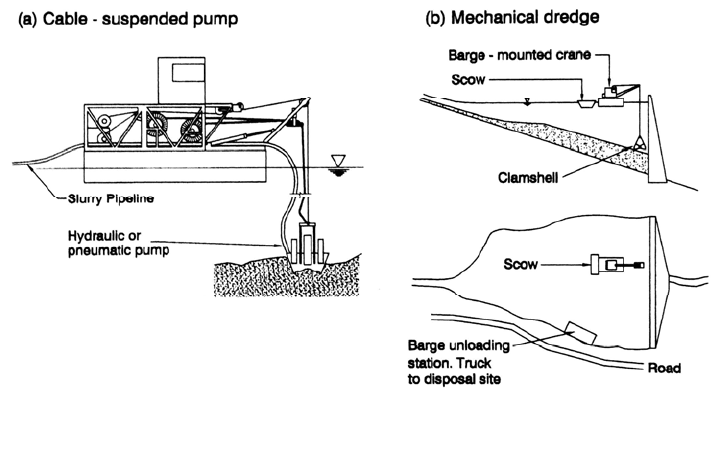
SEDIMENT EXCAVATION 16.10
FIGURE 16.7 (a) Cable-suspended dredge pump, capable of dredging to depths of 200 m. (b)
Clamshell mechanical dredge showing the associated barge required to transport sediment to the
shoreline.
unit excavation costs for these specialized pumping systems are significantly higher than
for conventional hydraulic dredges.
A cable-suspended pneumatic pump was used to dredge 0.55 Mm
3
of silt from
Gibraltar Reservoir at Santa Barbara, California, over a 3-year period. The sediment was
dredged and delivered to a containment site about 30 m above the reservoir level at an
average cost of $7.69/m
3
or $5.85/yd
3
(City of Santa Barbara, 1987). A more detailed
description is provided by Cooke et al. (1993).
16.3.5 Mechanical Dredges
A mechanical or bucket dredge excavates submerged sediments with a bucket (Fig.
16.7b). A barge-mounted clamshell may be used to excavate both fine and coarse
material. A fully enclosed clamshell design has been developed which can reduce
turbidity generation compared to the nonenclosed bucket. Mechanically dredged
sediment is deposited into a scow tied alongside the dredge, then is subsequently towed
to the edge of the reservoir for mechanical unloading and transport to the disposal sites.
Compared to hydraulic dredges, mechanical dredges deliver a product having low water
content, but the production rate is low. The bucket ladder dredge consists of a continuous
chain of open buckets and is used principally in the alluvial mining industry. It may be
suitable for use in a reservoir where gravels or larger material predominate. A bucket
ladder dredge will generate considerable turbidity.
16.3.6 Sediment Removal by Explosives
Explosives have been used to excavate or rehabilitate small stock ponds in rural areas of
the United States. The use of explosives to remove sediments in reservoirs has been
proposed at several sites, but the authors know of no site where any explosive technique
has been attempted on a significant scale. This section briefly reviews the status of
explosive techniques in reservoirs.

SEDIMENT EXCAVATION 16.11
A search of publications available in the Institute of Hydroelectric Power Research
and Water Conservancy in Beijing conducted by Guangdou Hu in 1988 revealed only a
few small-scale examples of the use of explosives in China. Explosives were used at the
small, seasonally empty Dashikau irrigation reservoir to break boulders so they could be
passed through a bottom sluice (this reservoir is shown in Fig. 15.7). Explosives were
also used on a pilot scale to excavate fine-grained material from exposed sediment beds
during reservoir emptying. Limited testing in China indicates that clayey sediments
rapidly attenuate shock, and a relatively small amount of material is moved in relation to
the explosive used. The blast-induced vibration propagates much better in saturated
Yellow River silts. For floodplain deposits in the Xiaolangdi Reservoir, it was estimated
that 0.67 kg of dynamite would be required to excavate 1 m
3
of channel volume on the
flood plain, and about half this amount of explosive for the side slopes of the channel.
Tolouie (1989) described a proposal to use explosives at the Sefid-Rud Reservoir in
Iran to hasten the collapse of channel banks during hydraulic flushing in the emptied
reservoir (Fig. 23.8). While this method could accelerate the rate of bank collapse, it is
not clear that it would significantly increase the total amount of sediment removal
compared to natural erosive processes. This method was not employed.
Explosive mobilization is a conceptual technique in which an underwater explosion
suspends sediment during a period of high-velocity flow, such as a sediment routing
event, which carries the resuspended sediment out of the reservoir. This strategy was
suggested by Allan Zack and analyzed by the first author at the Loíza Reservoir in Puerto
Rico, but was not recommended for testing or implementation. Several conditions must
be met for explosive mobilization to be successful:
Sediment removal will be significantly increased only when fine sediments, which
otherwise would not be eroded or would be eroded very slowly, are mobilized into
the flowing water. The explosion should suspend sediment as a cloud of fine
particles that can be carried away by the current, rather than as large clumps which
would settle back to the bottom.
Explosives emplaced in dewatered sediments before the flood season may remain
submerged for a prolonged period prior to detonation. Conventional techniques using
underwater electrical connections are not suitable for this application. A suitable
explosive technology might be based on the use of nitromethane, an extremely stable
industrial solvent which can be buried in drums and activated by an onshore
detonator, with blast transmission along a polyurethane pipeline filled with the
solvent (Trocino, 1991).
Many potential security, safety, and environmental issues must be addressed.
The best opportunity for successful explosive mobilization would occur where the timing
and rate of inflow are controlled by an upstream reservoir. However, it is unclear to what
extent the use of explosives might increase sediment removal over other methods, and the
possible economic advantages of using explosives have not been analyzed. This is a
highly unconventional technique, and any work in this area should obviously be initiated
on a pilot scale.
16.4 CONSIDERATIONS FOR RESERVOIR DREDGING
A dredging job can be considered in terms of four basic components: (1) the sediment to
be removed, i.e., the dredge site; (2) the equipment to remove and lift the sediment,
SEDIMENT EXCAVATION 16.12
i.e., the dredge; (3) the means to transport the dredged material, i.e., a pipeline for
hydraulic dredging; and (4) the dredged material disposal site.
16.4.1 Dredge Site
The site from which sediments are to be removed is defined in terms of both area and
depth. When the purpose of reservoir dredging is to establish a navigational channel, the
contractor must ensure that all sediment within the dredging template is removed, but the
contractor is not paid for the removal of sediment beyond a certain overdepth limit. In
contrast, reservoir dredging may be oriented to removal of a specified sediment volume
within a specified contour interval, rather than the attainment of precise geometry. In this
situation, greater tolerance may be specified for deviation from the planned dredging
template without contractor penalty, and areas with woody debris and hard material may
be avoided.
It is essential to know the grain size characteristics of the sediment to determine the
percentage of coarse sediment to be removed, based on boring data. Grain size
determines the minimum velocity required in the pipeline for solids transport and the
settling characteristics of the sediment in the disposal area. Because sediment can be
deposited in layers, it is essential to verify the grain size composition of the sediments
from borings which extend through the entire depth of the zone to be dredged. Surficial
sampling will not reveal the existence of these layered deposits. In small jobs, sediments
may be probed with a rod to determine their thickness and consistency. Sediment
sampling will also frequently be required for environmental monitoring. Because
regulatory requirements and the pollutants of concern will vary greatly from one area of
the world to another, the best strategy is to consult with the appropriate regulatory
agencies early in the planning stage, to ensure that all the required samples are collected,
and that the sampling and testing protocols are in compliance with agency requirements.
A hydraulic dredge also requires a staging area with an all-weather access road. The
staging area will typically be used to assemble and maintain dredging equipment, work-
boat access and docking, fuel and equipment storage, and contractor offices and parking.
Reservoirs may be subject to large and rapid changes in water levels, and in narrow
reservoirs floating equipment may be subject to high flow velocities during large floods.
Floating equipment or pipelines which are carried downstream by flood flow may
become lodged against gates. Flood conditions should be anticipated, and the contractor
must be able to properly secure equipment and pipelines in the event of flood.
16.4.2 Dredging Equipment
Almost all reservoir dredging is done with conventional hydraulic dredges. Special
situations that may require more specialized equipment (and warrant higher unit costs)
include removing contaminated sediments, dredging gravel and larger sediment, and
digging at depths exceeding about 15 m.
The dredge size required at a particular reservoir will depend on factors including the
desired production rate, digging depth, and distance and elevation change between the
dredge and the point of discharge. Figure 16.8 may be used to obtain a preliminary idea
of the relationship between dredge size and production rate for a conventional cutter-head
dredge without a ladder or booster pump. The typical horsepower range as a function of
dredge size is illustrated in Fig. 16.9. The maximum pumping rate may also be limited by
the surface area in the containment area; effluent turbidity will increase as a function of
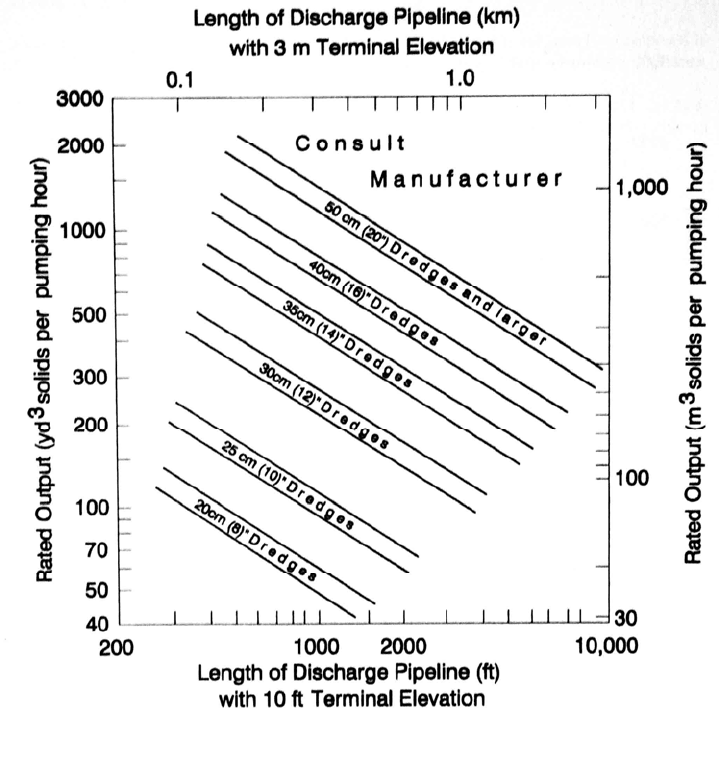
SEDIMENT EXCAVATION 16.13
FIGURE 16.8 Approximate relationship between dredge size and production rate
(redrawn from Herbich, 1992).
the hydra
ulic loading rate (discharge per unit surface area), and a large dredge pumping
into a small containment area can produce an effluent of unacceptable quality. A
hydraulic dredge pumps much more water than sediment, and if the dredge discharges
below the dam this may adversely affect the reservoir water balance.
Dredge sizing may also depend on local operational conditions. For instance, in some
cases an owner (or lake association) may prefer a small dredge with low capital costs and
simplified operation, and operate the machine for a period of several years to remove a
large volume of sediment. Or, a small dredge may be used to remove sediment at
approximately the same rate it is delivered to the reservoir.
Production time refers to the amount of time that the dredge is actually digging and
pumping slurry. Hydraulic dredges are usually operated 24 hours a day, but actual
dredging time will normally not exceed about 18 hours/day because of time spent in
activities such as equipment moves and maintenance. Using this guideline and knowing
the volume of sediment to be removed, the time to complete the job may be computed as
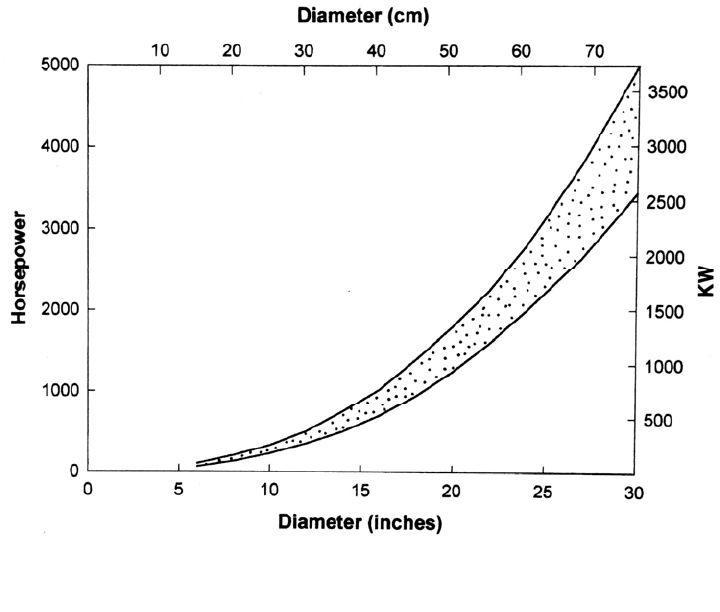
SEDIMENT EXCAVATION 16.14
FIGURE 16.9 Typical size of pumping units as a function of dredge suction diameter (based
on Turner, 1996).
a function of the dredge production rate. If there is a significant amount of debris, or
considerable aquatic or wetland vegetation in shallow areas, the actual production time
may be significantly reduced. Dredges smaller than about 50 cm (20 in) may be
particularly susceptible to reduced productivity because of roots from vegetation (Turner,
1996).
16.4.3 Pipeline System
A pipeline transports the sediment slurry from the dredging site to the point of discharge,
and, for a long pipeline, one or more booster pumps may be used. Pipelines may be made
of steel and supported on pontoons, or they may be made of sections of heat-welded high-
density polyethylene pipe, which has the advantage of being flexible and noncorrosive.
Having a specific gravity of about 0.95, the polyethylene pipe will float when filled with
water, but will sink when conveying slurry and thus requires the use of floats. Pipeline
wear (abrasion) is greatest when the pipe is transporting coarse sands and gravels, and
minimal when transporting fines.
Locating the pipeline route may be straightforward in a rural area, but in urban areas
it may be complicated by features such as development patterns, easements, road and
railroad crossings, etc. Whereas the dredge will move from one area to another, a booster
pump station may not be moved for the duration of the job. Booster pump locations
should be selected to minimize inconvenience and potential noise impacts, and
appropriate mufflers should be specified for pumps with diesel drives.
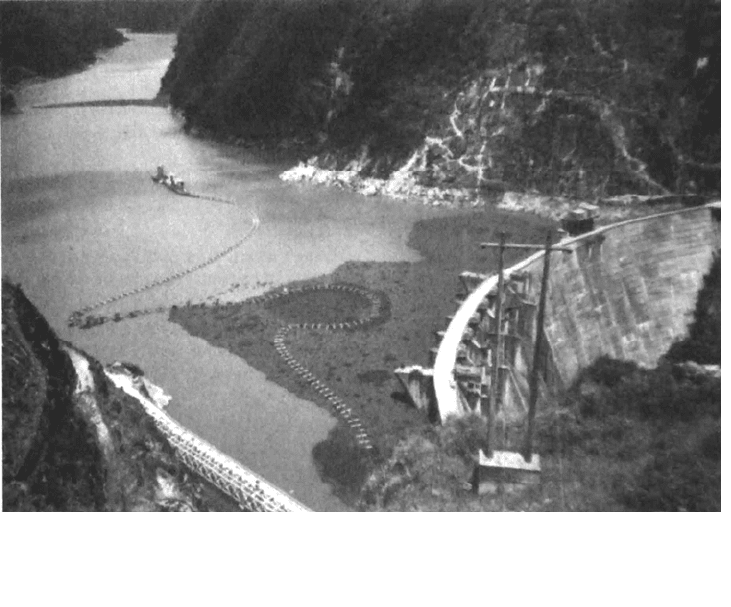
SEDIMENT EXCAVATION 16.15
16.4.4 Disposal Site
There are two basic strategies for the disposal of dredged sediment: riverine disposal to
the channel below the dam, or off-stream disposal into a diked upland containment area.
Riverine Disposal. The discharge of sediment below the dam is often the most
economical option from the standpoint of the dam owner. This may be especially true in
mountainous areas where large-capacity disposal sites are not readily available, such as at
Amaluza Reservoir on Ecuador's Paute River (Fig. 16.10), where dredged sediments are
discharged below the dam. Riverine discharge has been used at a number of reservoirs in
less industrialized areas, and siphon dredging requires discharge below the dam.
From the aspect of maintaining the continuity of sediment transport along the river
system, the disposal of dredged material into the river downstream of the dam would
appear to represent the best option. However, the year-round discharge of dredged
material is completely different from the episodic nature of sediment discharge under
natural conditions and can create large downstream impacts. Because the dredged
material will typically consist of fines from the area near the dam, rather than coarse
material deposited in the delta region that is most distant from the dam, the discharge of
dredged sediment will typically not remedy problems of riverbed degradation associated
with the trapping of coarse material above the dam. Riverine disposal is usually
prohibited in industrialized areas, and may also be infeasible in areas where otherwise
permitted by regulatory agencies because of adverse downstream impacts.
Sediment discharged below the dam and settling into downstream navigation
channels, intakes, or canals will need to be dredged again (usually by a different party).
FIGURE 16.10 Dredging at Amaluza hydroelectric reservoir in Ecuador during 1995, with
discharge to the river below the dam (A. Sotto).
